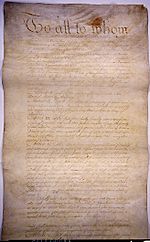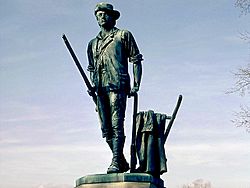Articles of Confederation facts for kids

The first page of the Articles of Confederation
|
|
| Quick Facts | |
|---|---|
| Ratified | March 1, 1781 |
| Approved By | Continental Congress |
| Purpose | First U.S. constitution |
| Replaced By | U.S. Constitution (1789) |
The Articles of Confederation, officially called the Articles of Confederation and Perpetual Union, was the first agreement that brought together the thirteen original states of the United States. It served as the country's first constitution. All thirteen states officially agreed to the Articles in early 1781.
In 1789, the Founding Fathers replaced the Articles. They created the United States Constitution and a new type of government called a federal system.
Contents
What Were the Articles of Confederation?

Even though many of the same people helped create both the Articles of Confederation and the Constitution, the two documents were quite different. The original Articles had five pages. It included thirteen main sections, a conclusion, and a place for signatures.
Here are short summaries of each of the thirteen sections:
- Article 1: The group of states would be called "The United States of America."
- Article 2: Each state would keep its own power and freedom. They would rule themselves in all areas not specifically given to the central government.
- Article 3: The states joined together to protect each other. They formed a group to help each other against attacks and to keep their freedoms safe.
- Article 4: People could travel freely between states. However, people who were poor, homeless, or running from the law were exceptions. If someone committed a crime in one state and ran to another, they would be sent back to face trial where the crime happened.
- Article 5: Each state got one vote in the "Congress of the Confederation." This Congress was also called the "United States in Congress Assembled." Each state could send between two and seven delegates to Congress. State legislatures chose these members. Members of Congress could not serve for more than three years out of any six-year period.
- Article 6: Only the central government could work with other countries and declare war. States could not have their own navies or full-time armies without Congress's permission. They also could not fight in wars on their own. However, the Articles encouraged each state to have militias (citizen armies).
- Article 7: When an army was needed for defense, state legislatures would choose the leaders, like Colonels, and other military ranks below Colonel.
- Article 8: The United States would pay for things using money raised by the state legislatures. States with more valuable property would pay more.
- Article 9: The central government had powers like declaring war. It could also set weights and measures (including coins). Congress also served as a final court for disagreements between states.
- Article 10: A "Committee of the States" would act as the government when Congress was not meeting.
- Article 11: Nine states had to agree before a new state could join the Confederation. Canada was already approved to join if it ever applied.
- Article 12: The Confederation agreed to pay back war debts from before the Articles were created.
- Article 13: The Articles could only be changed if Congress and all of the state legislatures agreed.
The Congress of the Confederation
The Articles of Confederation created a governing body called the Congress of the Confederation. Its official name was the "United States in Congress Assembled." This Congress was in charge of the United States. It had both the power to make laws (legislative) and to carry out laws (executive). Each state sent delegates chosen by their state legislature, and each state had one vote.
The Articles of Confederation also created the Committee of the States, sometimes called the Council of State. This committee was supposed to run the government when the full Congress was not meeting. Each state had one member on this committee. The Committee only met once, in 1784.
Gallery
See Also
- History of the United States
- United States Declaration of Independence
- United States Constitution
- United States Bill of Rights
Images for kids
-
1977 13-cent U.S. Postage stamp commemorating the Articles of Confederation bicentennial; the draft was completed on November 15, 1777
See also
 In Spanish: Artículos de la Confederación para niños
In Spanish: Artículos de la Confederación para niños















